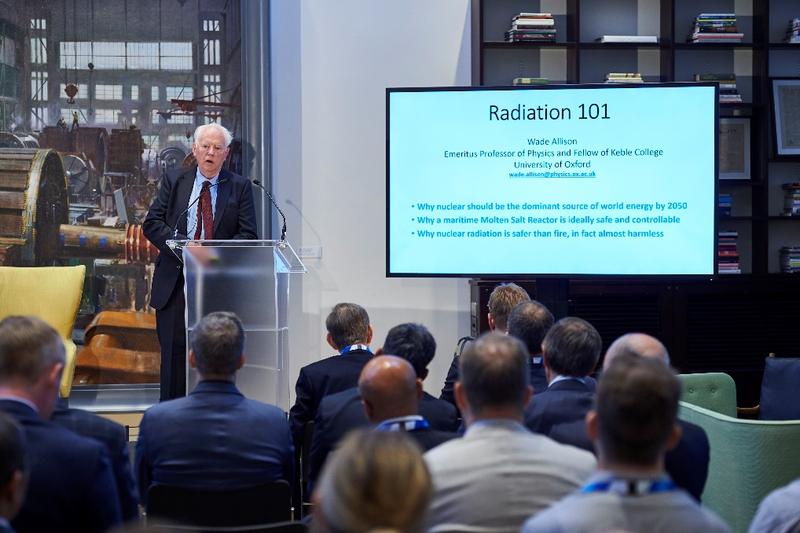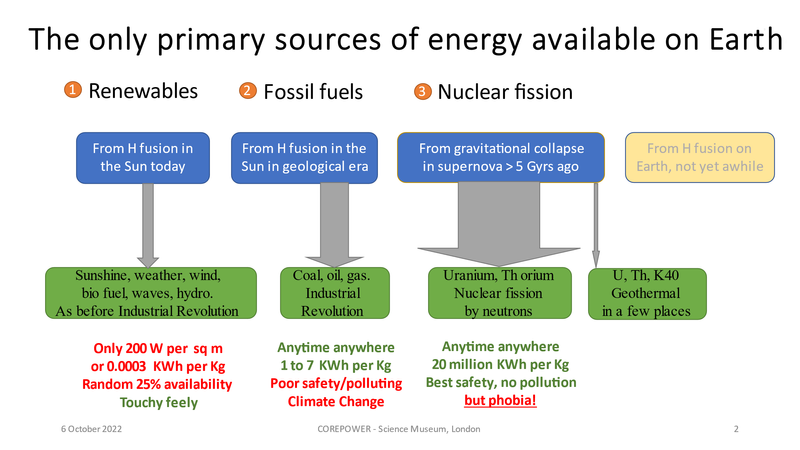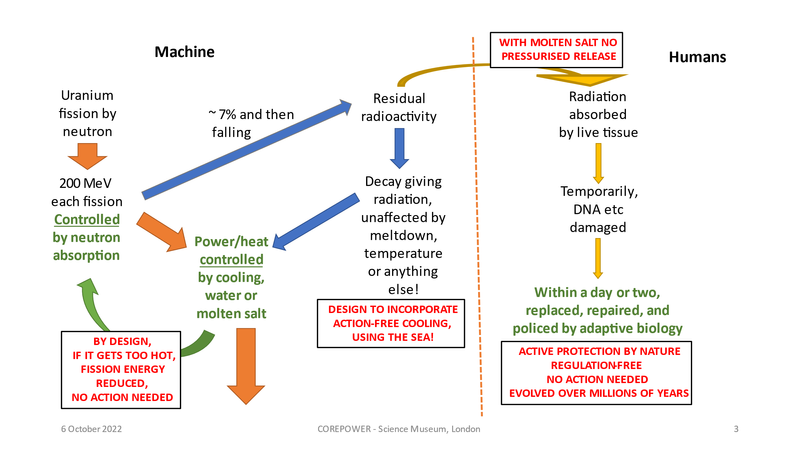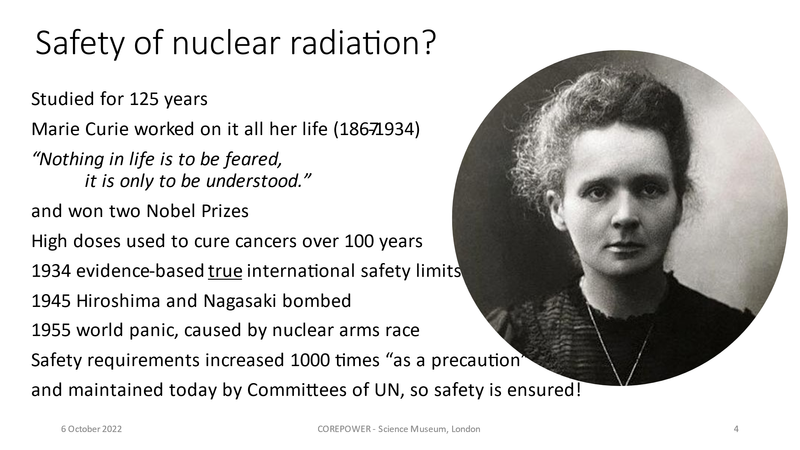This month
- Apologies from the Secretary
- Sizewell C news, as of 4 Nov
- EDF news
- Minutes of the 2022 Annual General Meeting of SONE
- Education needed on a grand scale – an editorial
- News from Rolls Royce
- News from Moltex
- Chinese molten-salt reactor cleared for start up
- TRISO fuel development in the UK
- “The Big Mistake”: A discussion with Ecomodernists in USA
- Renewables and batteries in trouble
- COREPOWER 6 October 2022
- SONE is now on Twitter
- Featured article: Achieving Net Zero by 2050
Apologies from the Secretary
Thanks to various delays including the AGM we missed the date for an October Newsletter. So this edition is larger and dated October/November.
Sizewell C news, as of 4 Nov
WNN reported on 7 October that Macron and Truss “confirmed the full support of the UK and French governments for the new nuclear power station at Sizewell and expect the relevant bodies to finalise arrangements in the coming month”. This followed Boris Johnson’s final act of committing the government to the project. However, since Truss stepped down and Sunak/Hunt took over, all such government financial commitments were said to be “on the table”, pending the Autumn Budget of Nov 17. Anti-nuclear sentiment eagerly fanned opinion in the press that SZC might be threatened. This became sufficiently widespread that Downing Street, anxious to keep other potential investors on board, let it be known that “Rishi Sunak’s spokesperson says claims they are ditching the £20bn project are not accurate and the government hopes to get a deal over the line as soon as possible”. 2.30pm 4/11/2022. The actual arrangements will become clearer on Nov 17, presumably.
EDF news
Meanwhile in France, EDF is to be nationalised – it is already largely state owned. Then recent strikes have delayed the benefit of positive technical news reported earlier by WNN:
EDF said it has completed stress corrosion repairs at three of its French reactors. “Repair work on circuits concerned by stress corrosion cracking examination on Bugey 4, Chinon B3 and Cattenom 4 reactors have been completed,” it said in a brief message on the EDF Transparency website. The reactors are scheduled to be restarted on 28 October, 14 November and 20 November, respectively.
And in the UK, EDF has announced that short life extensions for UK AGRs at Hartlepool and Heysham 1 are being considered in view of the energy crisis and the crack-free state of their graphite cores. This is extremely good news for all concerned,
Minutes of the 2022 Annual General Meeting of SONE
Held at The Institute of Civil Engineers, One Great George Street, London SW1P 3AA
Monday 17th October 2022 at 2pm
Present: Wade Allison, Ian McFarlane, Neville Chamberlain, Peter Havercan, Paul Spare, Chris Cockcroft, Marie Zabell, Richard Ollington, Judy McAlpine, Angus Ross, Johnny Ball and (by invitation) Candida Whitmill, Ian Fells, and Caspar Gleave.
- Apologies for absence were received from Bernard Ingham, John Assheton, Robert Maclachlan, Robin Smith, Adrian Bull, John Brenner, Ian Currie, Ken Durrands, Barrie Yates, Heather Eggins, Lord Vinson
- The Minutes of the previous Annual General Meeting held on October 4, 2021 (and circulated with the agenda) were accepted.
- There were no Matters Arising
- (Wade Allison took the chair for this item) Neville Chamberlain was re-elected Chairman of SONE for the year 2022/23 and a Director (nem con)
- Wade Allison was re-elected Honorary Secretary and a Director, and Ian McFarlane was re-elected Honorary Treasurer and a Director.
- The following were re-elected to the Committee for the year 2022/23: Neville Chamberlain, Wade Allison, Ian McFarlane, John Assheton, Adrian Bull, Robin Smith, Paul Spare, and Robert Maclachlan, Peter Havercan and Marie Zabell.
- The Directors’ Annual Report for 2021/22, previously circulated to all members by email, was discussed. The activity of the Company through its open monthly newsletters, posted articles and public engagements was described. The Report was approved by the Meeting.
- The Accounts for 2021/22, previously circulated to all members with the agenda, were introduced by the Treasurer. As in the previous year they showed a relatively low level of expenditure, largely from using email instead of postage, online instead of in-person meetings, and reduced administrative costs. Membership subscriptions have been stable. The Accounts were approved by the Meeting. Robert Maclachlan was thanked for preparing the short form of the Accounts.
- In general discussion the Treasurer reported that the financial situation was not currently a cause for concern. Savings have come from the new website, thanks to our new webmaster and SONE Committee Member, Peter Havercan. We now have a far better website without large outgoing fees. The Meeting thanked Peter for the considerable effort that he continues to put into this. The Secretary urged members to share SONE newsletters with young and old. Contributed articles are always welcome as are invitations to speak, online and in person. Every member of SONE should be encouraged to share the message and invite others to do so.
- Under any other business the Meeting was reminded that June 2023 will be the 25th Anniversary of the founding of SONE. The Committee will be considering how to mark the occasion.
- The Chairman regretted that despite his best efforts, no Minister had been forthcoming to address the Meeting. Ministers were understood to be busy with their own internal problems.
- The Chairman introduced Candida Whitmill, CEO, and Ian Fells, Directors of Penultimate Power. They outlined the development of their small (50 MWt and 22 MWe) high temperature gas-cooled reactors (HTGR) to be built on Teeside in collaboration with the Japanese (JAEA). Helium cooled and using TRISO fuel, their high temperature will provide thermodynamic efficiency and access to industrial processes not available with conventional reactors. The presentation generated enthusiastic discussion at the Meeting. The slides of the talk will be posted on the SONE website.
- The Meeting listened with enthusiasm to the views of a panel of
younger members, all of whom have a track record of speaking in
public for nuclear science:
Richard Ollington, member of SONE, has been interviewed a number of times on TV;
Marie Zabell, a member of the SONE Committee and cofounder of Mums4NuclearUK, who has also organised a number of street stalls and contributed engaging cartoons;
Caspar Gleave is a keen young physicist in his university gap year who has already hosted a number of interviews with eminent scientists, The Galileo Interviews.
In the discussion all agreed on the importance of getting more young people involved by reaching out into schools, past the views of teachers that are inevitably somewhat out-of-touch. - The Chairman closed the Meeting at 4.45 pm by thanking the five speakers for their enthusiastic contributions.
Education needed on a grand scale – an editorial
The variety of reactor designs and the public acceptance of nuclear energy are both advancing apace. History may decide that Putin’s attack on Ukraine helped to bring the world to a more sensible view of energy, though we are too close to that event to be sure. The unthinking consumption of fossil fuels and the “must have” demand for minerals in short supply, but required by renewables, cannot continue without serious environmental consequences, whether those include a changing climate or not. The belief that, with enough investment, technology is bound to develop a solution for any problem, even in defiance of natural science, has met its match. There is no solution to the supply of energy on the scale required that can compete with nuclear and respect nature.
Essential to the science are the numbers – although, unfortunately, numbers are what society has allowed most of its members to think they can leave to experts. The most important numbers are the values of the energy densities: for “renewables” 1/1000 KWh per Kg; for fossil fuels 1 to 10 KWh per Kg; for nuclear fuels 10 million KWh per Kg. The contrast between these is too large to be changed significantly by technical development or improved efficiency. Natural energy sources powered, directly or indirectly, by daily sunshine were rejected in favour of fossil fuels at the time of the Industrial Revolution as being too weak and intermittent – and they certainly have not changed. Those who argue that nuclear should just be “part of the mix” are equally ignoring the numbers. By 2050 renewables should no longer be “in the mix”. Then the world should be well on the way to nuclear as the sole primary energy source. That means thousands upon thousands of small local nuclear reactors, each being a source of secondary energy and other needs in the form of electricity, domestic heat, hydrogen, fresh water, and more.
So, although the nuclear renaissance has begun, there is a long way to go – thirty years of public education, as well as further development and deployment. It is unfortunate that “renewables” have become fashionable - encouraged by the disingenuous advertising of the fossil fuel industries. But public opinion can switch with surprising speed. Think how quickly it turned against smoking. According to a YouGov Poll quoted by WNN, Britons are increasingly supportive of nuclear energy, even though perceptions of its safety remain unchanged
Between late 2019 and summer 2021, Britons were divided on using nuclear power, with around 40% over that time period supporting its use, with a similar number opposing it. Since then, support has increased with almost half (48%) of Britons now backing the use of nuclear energy, compared with 31% who are opposed. Over the same time period, the number of Britons who say nuclear power is the source they support most for helping meet the UK’s future energy needs has risen from 16% to 24%.
In France too, opinion on the street is remarkably sensible. https://twitter.com/emergencyreact/status/1576134838117089280
The UK Government projections of the need for nuclear energy by 2050 are woefully short. The Government – and everybody else, too – should note how the Chinese and Russians are emphasising nuclear energy as a source of domestic and industrial heat as much as electric power. https://www.neimagazine.com/news/newsrussias-floating-npp-supplies-heat-to-second-pevek-district-9877829 Other studies have reached similar conclusions. https://static1.squarespace.com/static/56eddde762cd9413e151ac92/t/63219d0abc3427001b998a49/1663147275538/Keeping+the+Lights+On+%281%29.pdf
If the UK is to have a viable export trade in nuclear plant, the rate of expansion of the nuclear industry should be all the greater! This expansion will be limited by know-how, patents and experienced manpower. These are where the investment should now be made and the UK has a workforce that could, and should, be ramped up to provide manpower for domestic and export needs. It is relevant that nuclear jobs are at new high https://namrc.co.uk/industry/jobs-map-2022/ although the tendency to focus on fusion power seems unbalanced. The new Nuclear Skills Academy that Rolls-Royce Submarines Ltd has opened in Derby is the first of its kind and aimed at sustaining “nuclear capability within the UK’s submarines programme by creating a dedicated pipeline of talent. The academy is supported by industry and education experts, including the Nuclear Advanced Manufacturing Research Centre, the National College for Nuclear, the University of Derby and Derby City Council. It received more than 1200 applicants for only 200 places in its 2022-23 academic year. Applications for 2023-24 academic intake will be opening from October 2022” it says.
News from Rolls Royce
As reported by WNN (15 September), Estonia’s Fermi Energia has said it will accept tenders from three SMR developers: GE Hitachi, NuScale, and Rolls-Royce. The company said bids with comprehensive technical documentation needed to estimate the construction cost are expected by December, and the technology selection will be made in February 2023.
RR previously announced six potential locations for the module factory, picked from more than 100 submissions from local enterprise partnerships and development agencies. Sunderland in Tyne and Wear, Richmond in North Yorkshire, Deeside in Wales, Ferrybridge in Yorkshire, Stallingborough in Lincolnshire, and Carlisle in Cumbria. WNN reports that they have now added two more locations - Shotton, Deeside, in North Wales, and Teesworks, Redcar, in north east England. https://www.world-nuclear-news.org/Articles/Two-sites-added-to-Rolls-Royce-SMR-s-UK-factory-sh
WNN also reports that the Dutch nuclear energy development company ULC-Energy BV has signed a Memorandum of Understanding (MoU) with US utility Constellation to support the deployment of a fleet of Rolls-Royce small modular reactors (SMRs) in the Netherlands. https://www.world-nuclear-news.org/Articles/Constellation-to-help-Dutch-Rolls-Royce-SMR-deploy
News from Moltex
MoltexFLEX, a subsidiary of Moltex that is based in Warrington, has
launched a flexibly-operated molten salt reactor. It does not use
recycled nuclear fuel but does employ the dual salt technology like the
Canadian SSRW. Each reactor is said to develop 40 MWt, but the WNN
report refers to a 500 MW plant. Curiously, the aim is to be able to
follow fluctuating renewables. Why such a reliable plant should see a
principal virtue in being able to complement horse-and-cart technologies
is unclear. Marine application is mentioned.
https://world-nuclear-news.org/Articles/MoltexFLEX-launches-flexibly-operated-molten-salt
Chinese molten-salt reactor cleared for start up
A 2 MW Thorium demonstration fluoride-cooled Molten Salt Reactor has been completed
a year ahead of time.
https://www.world-nuclear-news.org/Articles/Chinese-molten-salt-reactor-cleared-for-start-up
If the UK Government understood the problem of energy it would have
supported similar work by Moltex instead of leaving initiatives to China
and Canada.
TRISO fuel development in the UK
Positive news about cooperation on fuel development in the UK at Springfield https://www.world-nuclear-news.org/Articles/Westinghouse-to-study-UK-production-of-advanced-nu
“The Big Mistake”: A discussion with Ecomodernists in USA
A lengthy discussion of the history of life and energy, and what it says about education and the choice we should make for the future of our children:
It should be illustrated slides and data, as most such talks usually are, but sometimes the wood then gets lost in the trees. So, on this occasion it is just talk.
Renewables and batteries in trouble
The situation for the promoters of wind, solar and biofuels is bleak. Reality fails to match the public image. Their supposedly low cost ignores the politically limited availability of the exotic minerals required in the manufacture of solar panels, wind turbine magnets using rare earth elements. Then there is their limited lifetime, a quarter of that for a nuclear station. They cover a large area and are vulnerable to extreme weather and attack by an enemy. Despite being called farms they displace nature like a permanent building site. But their intermittency is their greatest failing, requiring a reliable back-up – in which case why not settle for the back-up alone. The alternative is to build very large batteries. With falling investment in wind and solar, investment in batteries is a bright spot, they say. https://www.energy-storage.news/energy-storage-a-bright-spot-for-us-clean-energy-as-wind-solar-deployments-fall/ But then another posting says that batteries are doing badly too. https://www.energy-storage.news/economic-climate-starts-to-bite-for-battery-gigafactory-projects-in-europe/ The large quantities of exotic elements that are needed but in limited supply, like Cobalt from the Congo, cause rising prices. Then, batteries do not last many years before their chemistry deteriorates.
Or perhaps a small nuclear power station with an 80 year lifetime? Oh, that’ll do nicely, Sir.
COREPOWER 6 October 2022
At the World’s First Nuclear Maritime Conference, Science Museum, London.

Basic reassurance for investors, ship owners and crew presented in three slides:
- overwhelming case for nuclear as the source of energy;
- the control and protection of a marine Molten Salt Reactor unit;
- the natural biological safety provided by the evolution of life.



SONE is now on Twitter
SONE has recently created an account on Twitter, at https://twitter.com/SuppOfNucEnergy.

This should help to promote our presence on social media, and to drive visitors to our website. Members who have a Twitter account are encouraged to follow, “like”, and retweet posts, as appropriate.
SONE has also has a presence on LinkedIn at https://www.linkedin.com/company/supporters-of-nuclear-energy/, but it needs work!
Featured article: Achieving Net Zero by 2050
Candida Whitmill’s presentation to the AGM, Achieving Net Zero by 2050, is this month’s featured article.
Link: https://sone.org.uk/achieving-net-zero-by-2050/
Wade Allison5 November 2022
